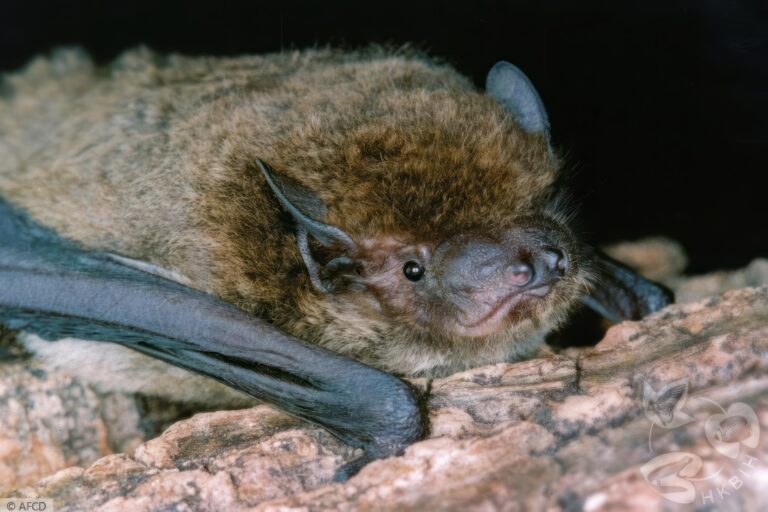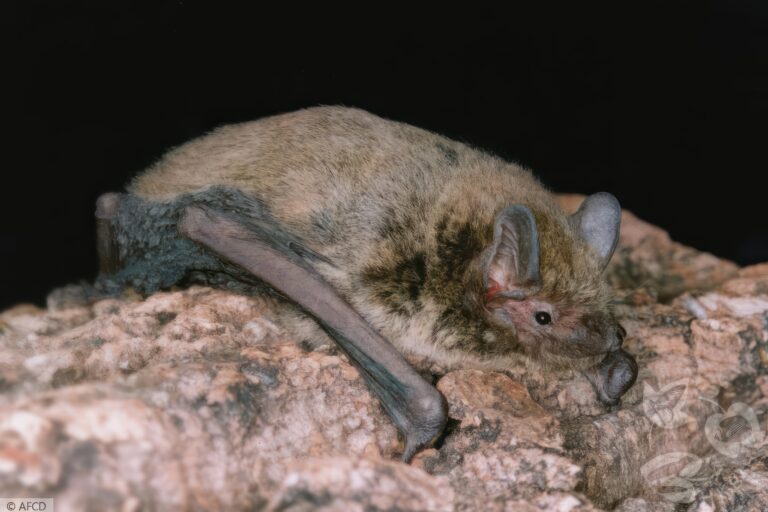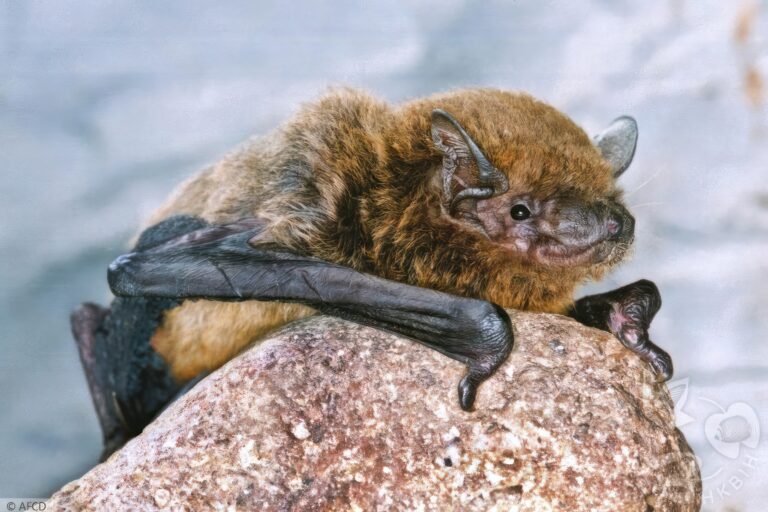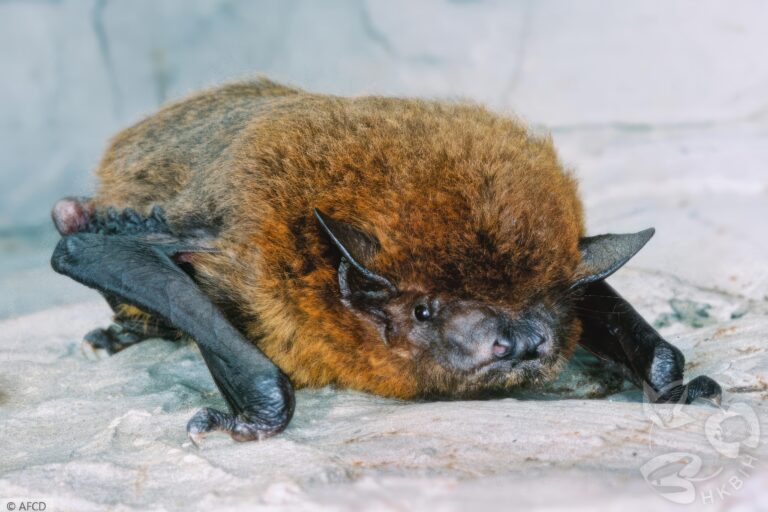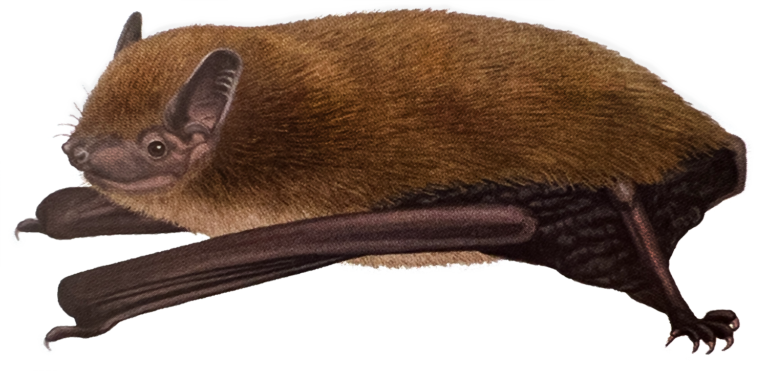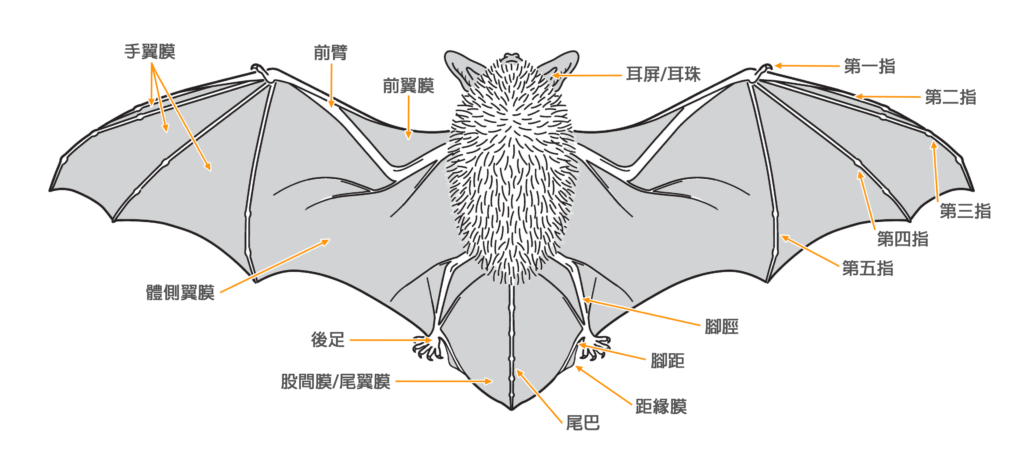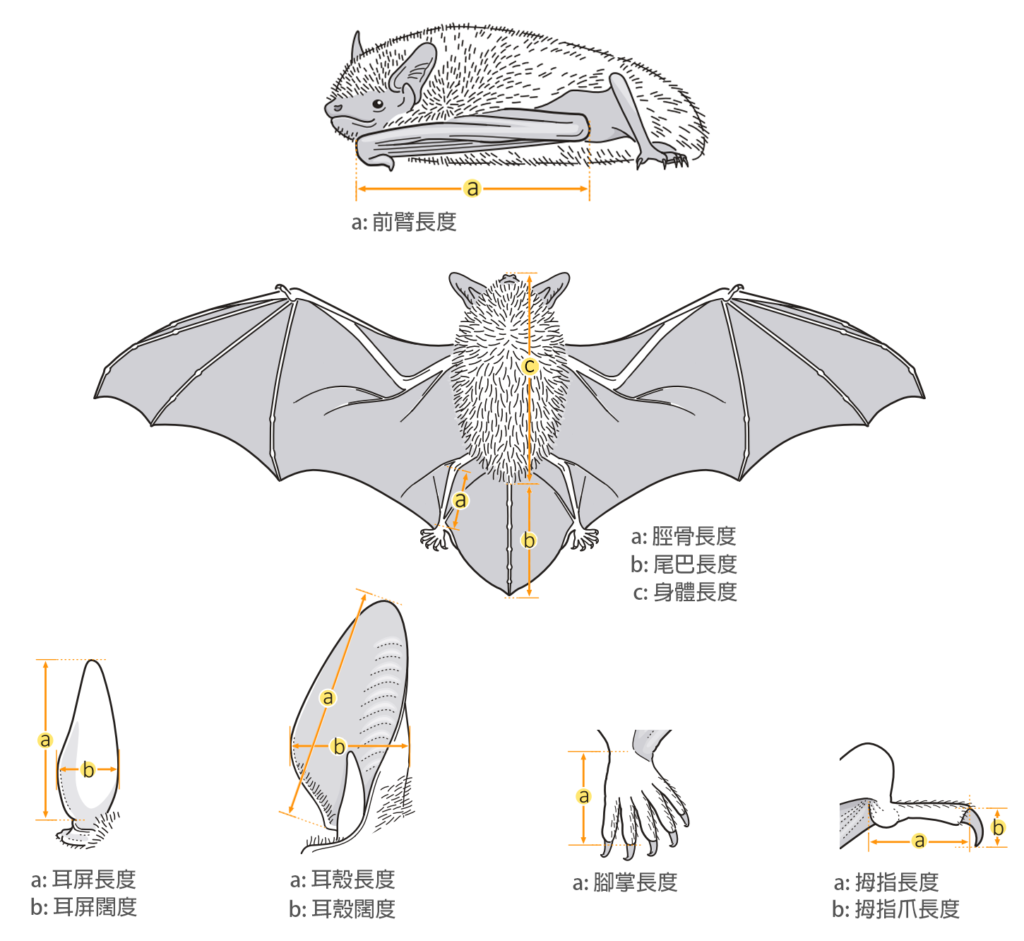- 香港蝙蝠資訊站
- 錫蘭伏翼 Kelaart’s Pipistrelle
錫蘭伏翼(疑似)
Kelaart's Pipistrelle
Pipistrellus ceylonicus (Kelaart, 1852)
分類學
| 科: | 蝙蝠科 (Vespertilionidae) |
| 屬: | 伏翼屬 (Pipistrellus ) |
| 學名: | Pipistrellus ceylonicus (Kelaart, 1852) |
| 異名: | Scotophilus ceylonicus Kelaart, 1852 |
| 亞種: | Pipistrellus ceylonicus raptor Thomas, 1904 |
| 本地英文名: | Kelaart's Pipistrelle |
| 其他英文名: | Dark Brown Pipistrelle |
| 本地中文名: | 錫蘭伏翼 |
| 其他中文名: | 斯里蘭卡伏翼、凱氏伏翼、東方伏翼、錫蘭油蝠 |
| 分類註釋: |
在漁農自然護理署制訂的《香港陸棲哺乳動物名錄》中,有一種尚未確認的伏翼蝠 Pipistrellus sp.1 。在《香港陸上哺乳動物圖鑑》中曾引述匈牙利自然歷史博物館的分析,認為該伏翼蝠可能是新物種,但仍有待確認。其後,在2013年出版的《Bats of Vietnam: Checklist and an identification manual》中,Sergei V. Kruskop 在匈牙利自然歷史博物館鑑定出一個來自香港的錫蘭伏翼北部灣亞種P. ceylonicus raptor 標本。在本地已知的伏翼屬中,只有Pipistrellus sp.1 符合P. c. raptor 的體型特徵(前臂長 36 - 39 mm),因此該標本很可能就是當年匈牙利自然歷史博物館曾鑑定的Pipistrellus sp.1。 為進一步印證Sergei V. Kruskop 所鑑定的P. c. raptor 標本為本地的Pipistrellus sp.1,本站試以最新的分類指引為Pipistrellus sp.1 作粗略鑑定(Cheng et al., 2022; Kruskop, 2013; Srinivasulu et al., 2010)。Pipistrellus sp.1 的體型相對地大,前臂長達 38.5 mm 且陰莖長約 10 mm (Shek, 2006),在整個東南亞地區已知的11種伏翼屬中 (Cheng et al., 2022; Francis, 2019; Simmons & Cirranello, 2020),排除形態獨特且為另一亞屬 Alionoctula 的 Pipistrellus stenopterus 後,現時只有P. ceylonicus 符合其分類特徵。而在華南地區已知的P. ceylonicus 亞種有2種,包括分布於海南省的P. c. tongfangensis 及分布於廣西省的P. c. raptor 。本地的Pipistrellus sp.1 的毛色較灰暗,毛基呈烏黑色,與 P. c. raptor 的分類特徵吻合 (Shaw et al., 1966; Thomas, 1904; Wang et al., 1962),與Sergei V. Kruskop 的鑑定結果相符。因此,本地的Pipistrellus sp.1 很可能就是錫蘭伏翼北部灣亞種P. ceylonicus raptor。雖則如此,Pipistrellus sp.1 的分類地位仍需待更嚴謹及確切的鑑定才能確立。 |
| 外形特徵 | |
| 毛色: | 毛色多變,可呈灰棕色、粟棕或金棕色,一般呈灰棕色。背毛呈灰棕至深棕色(基部烏黑色、未端呈不同亮度的棕色);腹毛顏色較淺,呈淺灰棕色(基部烏黑色、未端呈淺棕色);有些個體頸圈位置的毛端會略呈金棕色 |
| 耳殼: | 耳殼呈暗褐色,略呈三角形,耳尖圓鈍 |
| 耳屏: | 耳屏形狀特別,呈短闊的姆指狀;後緣均勻地向前彎曲,且明顯外翻,頂端明顯向前突出,呈深棕色;前緣下半部筆直或微凹;基部寬闊且顏色較淡 |
| 頭部: | 吻及臉部呈暗褐色,吻部兩側明顯脹大有腺體,於緊迫時會分泌黃綠色液體;眼睛圓大 |
| 四肢: | 翼膜連接至趾基 |
| 尾部: | 尾長,完全被股間膜包裹,末端(< 1 mm)略微突出於股間膜;腳距長(~6.6 mm),由足踝延伸至尾膜後緣之半,略呈S形,具發達而呈三角形的距緣膜,膜中央具明顯的橫軟骨隔膜 |
| 陰莖: | 陰莖長而明顯(~10 mm),後半部呈棕色,覆茂密米白色短毛;陰莖骨特長,可長達12.8 mm |
| 體形及體重測量 | |
| 體型: | 大型伏翼蝠 |
| 軀幹: | 45.0 - 64.0 mm |
| 尾長: | 30.0 - 45.0 mm |
| 耳長: | 9.0 - 14.0 mm |
| 後足: | 6.0 - 11.0 mm |
| 前臂: | 33.0 - 42.0 mm |
| 體重: | 7.0 - 10.0 g |
| 翼形參數 | |
| 翼長: | 0.250 m |
| 翼面積: | - |
| 翼載: | - |
| 翼展比: | - |
| 翼尖指數: | - |
| 參考資料: | Madhavan, 1971 |
生態資料
| 生境: | 適應性很強的蝙蝠,能棲息於多種生境,包括林區、鄉郊及市區公園。主要棲身於建築物的隙縫(樓頂、屋簷、牆洞、牆隙等)、樹洞、洞穴、井及橋底等等,亦可棲息於蝙蝠箱。 |
| 習性: | 獨自棲息或組成中小型群落,群落一般由數隻至數百隻個體組成。 |
| 繁殖: | 參考印度中部的繁殖紀錄,錫蘭伏翼的繁殖周期為一年一代的季節性繁殖。交配期在六月上旬至七月中旬,雌蝠在七月中旬才排卵,以延遲受精的方式受孕。妊娠期為50-55天,在八月中旬至九月中旬分娩,一胎1-3隻幼蝠(通常2隻)。育幼期一般只維持25-30天,期間母蝠有機會會放棄發育不佳或不慎落地的幼蝠。 |
| 冬眠: | 在溫度較低或雨天時,會進入短暫的蟄伏狀況,未有其冬眠的本地紀錄。 |
| 飛行: | 飛行速度很快且靈活性良好,速度比東亞家蝠、小伏翼及灰伏翼更快;一般在較高的空曠空域飛行,覓食時亦會低飛,飛行時會進行許多扭轉和轉彎,也會直線飛行。 |
| 覓食: | 一般在日落前後飛離棲所,外出覓食,約一小時後返回棲地休息。會圍繞著街燈盤旋,獵食趨光昆蟲,亦會在空曠的空域覓食。 |
| 食性: | 食蟲性蝙蝠,於空中捕食昆蟲,主要捕食甲蟲、飛蛾、蒼蠅和其他昆蟲。 |
分布概況
| 本地分布: | 新界 |
| 全球分布: | |
| P. c. ceylonicus | 斯里蘭卡 |
| P. c. borneanus | 北婆羅洲的特魯斯馬迪山(一個標本) |
| P. c. indicus | 巴基斯坦東部和東南部(旁遮普和信德省)、印度和孟加拉 |
| P. c. raptor | 中國南部(廣西南部、潿洲島)及越南 |
| P. c. shanorum | 緬甸中東部 |
| P. c. tongfangensis | 中國(海南島) (Moratelli et al., 2019) |
本地分布地圖

全球分布地圖
(Moratelli et al., 2019)
本地狀況及載列名錄
| 首次紀錄: | 2005年 |
| 物種來源: | 原生 |
| 本地現況: | 稀有 (Shek & Chan, 2006) |
| 國內現況: | 無危 (中國脊椎動物紅色名錄) |
| 全球現況: | 無危 (IUCN紅色名錄) |
| 潛在威脅: | 待續 |
回聲定位

如有需要,請先註冊會員,並以電郵方式聯絡小蝙申請閱讀權限。
| Parameter | Value |
|---|---|
| Call structure | FM |
| Duration | 1.40 ± 0.40 ms |
| Inter pulse interval | - ms |
| Peak frequency |
44.00 ± 4.00 kHz (41.30 - 49.90 kHz) |
| Highest frequency |
101.70 ± 2.00 kHz (98.70 - 103.80 kHz) |
| Lowest frequency |
32.80 ± 0.40 kHz (32.40 - 33.30 kHz) |
| 亞種: | P. c. indicus |
| 錄音地區: | 印度 |
| 錄音方式: | 錄音棚 |
| 參考資料: | Raghuram et al., 2014 |
| Parameter | Value |
|---|---|
| Call structure | FM |
| Duration | 2.57 ± 0.60 ms |
| Inter pulse interval | - ms |
| Peak frequency |
38.64 ± 1.99 kHz ( 34.90 - 45.50 kHz) |
| Start frequency |
59.45 ± 9.11 kHz (40.20 - 91.30 kHz) |
| End frequency |
35.57 ± 1.62 kHz (31.00 - 42.62 kHz) |
| 亞種: | P. c. indicus |
| 錄音地區: | 印度 |
| 錄音方式: | 人手放飛 |
| 參考資料: | Wordley et al., 2014 |
| Parameter | Value |
|---|---|
| Call structure | FM |
| Duration | 2.50 ± 0.37 ms |
| Inter pulse interval | 83.50 ± 21.10 ms |
| Peak frequency |
42.30 ± 2.43 kHz (39.00 - 45.00 kHz) |
| Highest frequency |
111.80 ± 8.24 kHz (98.00 - 121.50 kHz) |
| Lowest frequency |
34.70 ± 0.27 kHz (34.40 - 35.30 kHz) |
| 亞種: | P. c. indicus |
| 錄音地區: | 印度 |
| 錄音方式: | 飛行帳蓬&人手放飛 |
| 參考資料: | Raman & Hughes, 2020 |
參考資料
Cheng, H. C., Fang, Y. P., & Chou, C. H . (2022). A Photographic Guide to the Bats of Taiwan (4th ed.). Endemic Species Research Institute.
Francis, C. (2019). Field guide to the mammals of South-east Asia. Bloomsbury Publishing.
Javid, A., Rasheed, B., Zeb, J., & Khan, M. I. (2019). Morphological Differentiation in Some Pipistrellus sp. (Chiroptera) Captured from Bajaur Agency, Pakistan. Pakistan Journal of Zoology, 51(2).
Jiang, Z. G., Jiang, J. P., Wang, Y. Z., Zhang, E., Zhang, Y. Y., Li, L. L., Xie, F., Cai, B., Cao, L., Zheng, G. M., Dong, L., Zhang, Z. W., Ding, P., Luo, Z. H., Ding, C. Q., Ma, Z. J., Tang, S. H., Cao, W. X., Li, C. W., Hu, H. J., Ma, Y., Wu, Y., Wang, Y. X., Zhou, K. Y., Liu, S. Y., Chen, Y. Y., Li, J. T., Feng, Z. J., Wang, Y., Wang, B., Li, C., Song, X. L., Cai, L., Zang, C. X., Zeng, Y., Meng, Z. B., Fang, H. X., & Ping, X. G. (2016). Red List of China’s Vertebrates. Biodiversity Science 24(5), 500‑551.
Kruskop, S. V. (2013). Bats of Vietnam: Checklist and an identification manual. Tovarishchestvo nauchnykh izdaniĭ KMK.
Kusuminda, T., Mannakkara, A., Patterson, B. D., & Yapa, W. B. (2018). Bats in tea plantations in Sri Lanka: species richness and distribution. Journal of Bat Research & Conservafion Volume, 11, 1.
Madhavan, A. (1971). Breeding habits in the Indian vespertilionid bat, Pipistrellus ceylonicus chrysothrix (Wroughton). Mammalia, 35(2), 283-306.
Moratelli, R., Burgin, C., Cláudio, V., Novaes, R., López-Baucells, A., & Haslauer, R. (2019). Vespertilionidae. In Mittermeier, R. A., & Wilson, D. E. (Eds.), Handbook of the Mammals of the World – Volume 9 Bats. (pp. 716-981). Lynx Edicions.
Raghuram, H., Jain, M., & Balakrishnan, R. (2014). Species and acoustic diversity of bats in a palaeotropical wet evergreen forest in southern India. Current Science, 107(4), 631-641.
Raman, S., & Hughes, A. C. (2020). Echobank for the bats of Western Ghats biodiversity hotspot, India. Acta Chiropterologica, 22(2), 349-364.
Roberts, T. J. (1997). The mammals of Pakistan. Oxford University Press.
Smith, A. T., & Y. Xie (eds.). 2013. Mammals of China. Princeton University Press.
Smith, A. T., Xie, Y., Hoffmann, R. S., Lunde, D., MacKinnon, J., Wilson, D. E., & Wozencraft, W. C. (Eds.). (2010). A guide to the mammals of China. Princeton University Press.
Shek, C. T. (2006). A Field Guide to the Terrestrial Mammals of Hong Kong. Friends of country park and cosmos book limited.
Shek, C. T., & Chan, C. S. M. (2006). Mist Net Survey of Bats with Three New Bat Species Records for Hong Kong. Hong Kong Biodiversity, 11, 1-7.
Simmons, N. B., & Cirranello, A. L. (2020). Bat species of the world: a taxonomic and geographic database.
Srinivasulu, C., Racey, P. A., & Mistry, S. (2010). A key to the bats (Mammalia: Chiroptera) of South Asia. Journal of Threatened taxa, 2(7), 1001-1076.
Tate, G. H. H. (1942). Review of the vespertilionine bats: with special attention to genera and species of the Archbold collections. American Museum of Natural History, 80, 221-297.
Thomas, O. (1904). XLVI. – Three new bats, African and Asiatic. Journal of Natural History, 13(77), 384-388.
Tong, C. P. (2016). Distribution and preference of landscape features and foraging sites of insectivorous bats in Hong Kong urban parks. [Master’s thesis, The University of Hong Kong].
Wei, F. W., Yang, Q. S., Wu, Y., Jiang, X. L., Liu, S. Y., Li, B. G., Yang, G., Li, M., Zhou, J., Li, S., Zhou, J., Li, S., Hu, Y. B., Ge, D. Y., Li, S., Yu, W. H., Chen, B. Y., Zhang, Z. J., Zhou, C. Q., Wu, S. B., Zhang, L., Chen Z. Z., Chen, S. D., Deng, H. Q., Jiang, T. L., Zhang, L. B., Shi, H. Y., Lu, X. L., Li, Q., Liu, Z., Cui, Y. Q., & Li, Y. C. (2021). Catalogue of mammals in China (2021). Acta Theriologica Sinica, 41(5), 487–501.
Wordley, C. F., Foui, E. K., Mudappa, D., Sankaran, M., & Altringham, J. D. (2014). Acoustic identification of bats in the southern Western Ghats, India. Acta Chiropterologica, 16(1), 213-222.
汪松、陸長坤、高耀亭、蘆汰春(1962)。 廣西西南部獸類的研究。動物學報,14(4),555-568。
壽振黃、汪松、陸長坤、張鑾光(1966)。海南島的獸類調查。動物分類學報,3(3),260-274。
徐劍、鄒佩貞、溫彩燕、陳建榮、吳毅(2002)。廣東省大陸翼手目動物區系與地理區劃。中山大學學報:自然科學版,41(3),77-80。
Hong Kong Bat Radar. (06/05/2024). A Field Guide to Bats of Hong Kong: Kelaart’s Pipistrelle (Pipistrellus ceylonicus ). https://hkbatradar.com/en/pipistrellus_ceylonicus

